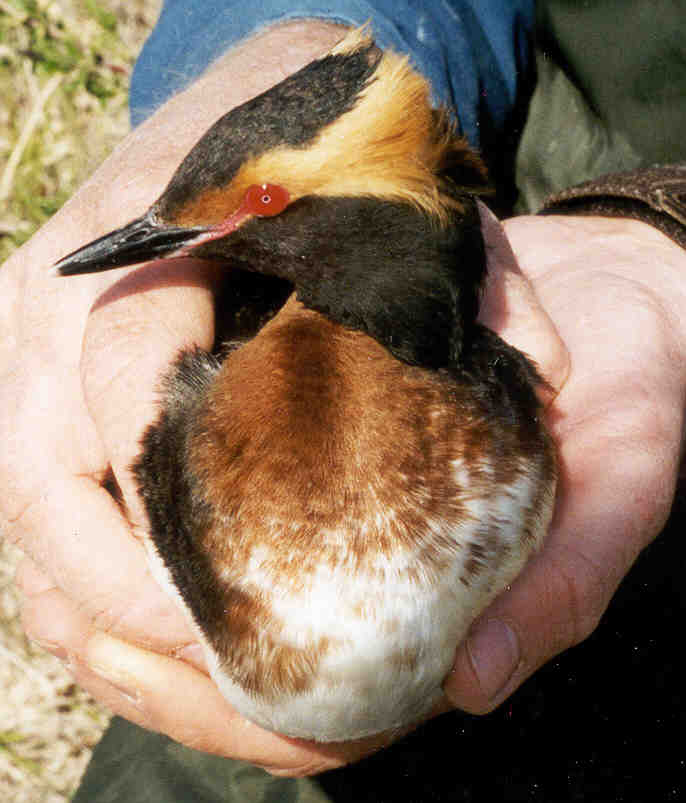

(Currently studied by CWE researcher Bonnie Stout)
Ongoing grebe research at CWE is focusing primarily on two species, Red-necked Grebe (Podiceps grisegena) and Horned Grebe (Podiceps auritus).
Bonnie Stout is conducting Ph.D. research on several aspects of the annual cycle in these species, examining life history strategies in grebes. Life history questions being examined include, pair formation, breeding site and mate fidelity, breeding and parental care, and moult.
When and where do grebes form pair bonds? While most birds find mates at breeding areas, some birds find mates away from breeding areas, such as at wintering sites. Pair formation in some, such as many waterfowl, may occur months before breeding. Various hypotheses have been offered to explain the circumstances in which birds might form early pair bonds. In examining the question in grebes, we can evaluate the generality of some of these hypotheses. Additionally, pair formation timing and location has important implications for genetic population structure. Fieldwork for this question takes place both at grebe wintering areas in southern coastal BC, and at breeding sites near Yellowknife, NT. Patterns of mate and breeding site fidelity in Horned Grebes and Red-necked Grebes are being examined through banding and colour marking of grebes nesting near Yellowknife, NT. Habitat characteristics that influence patterns of site and mate fidelity may also influence timing of pair formation. Red-necked Grebes show fairly high levels of both mate and site fidelity at Yellowknife, while Horned Grebes appear more flexible in their year-to-year choices of both mates and breeding ponds.
How grebes meet the demands of raising young is another question under study. Of particular interest is how the costs of parental care are balanced between mates and against other demands of the annual cycle, such as moult. Grebes pose many interesting questions about reproduction strategies. They have shared parental care, asynchronous hatching of young (which leads to competitive disparities in the brood), and, in some species, brood division between parents in later stages of brood rearing.
Finally, we are interested in how moult interacts with breeding, migration, and pair formation strategies in grebes. Red-necked and Horned Grebes undergo one complete moult in late summer/fall and a partial moult in late winter/spring. The complete moult includes simultaneous molt of flight feathers, rendering the grebes flightless for about 3 weeks or more. Habitat choices for the simultaneous wing moult are of particular interest both to understand life history strategies in grebes, and for conservation purposes. A few moult sites have been identified for Red-necked and Horned Grebes, but much of their North American populations are unaccounted for during this period.
Previous Grebe research at CWE
Western Grebe (Aechmophorus occidentalis)
In 1998, James Clowater completed his Master's project on Western Grebes with his thesis "Distribution and foraging behaviour of wintering Western Grebes". James examined both seasonal and diurnal distribution patterns of Western Grebes wintering in the Sannich Inlet, BC. He observed Western Grebe foraging behaviour, and made the interesting discovery that Western Grebes in the Sannich Inlet forage primarily from dusk until dawn and that most birds gather in roosting flocks during daylight hours. The grebes apparently take advantage of vertically migrating prey that moves to surface waters at night. James suggested that the nocturnally foraging grebes are aided in locating fish prey through ambient marine bioluminescence.
Eared Grebe (Podiceps nigricollis)
In 1998, Sean Cullen completed his Master's project on Eared Grebes with his thesis "Population biology of Eared Grebes in naturally fragmented habitat". Sean's research took place at Riske Creek, in the Fraser Plateau of BC, where Eared Grebes nest in the ponds of Becher's Prairie. Sean banded and colour marked and radio-marked large numbers of Eared Grebes, using these marked birds to track inter- and intra-seasonal movements. Sean developed a discriminant function to predict the sex of captured birds based on bill measurements, and examined patterns of site fidelity and movements. Using a metapopulation framework, Sean concluded that Eared Grebes at Becher's Prairie exhibit a "flexible settling" pattern of site fidelity. Birds with prior breeding experience in the area returned in subsequent years, but while some remained in the pond or study site, others departed the area after a short stay. Between-pond movements where greatest in the months of June and August. June movements may be attributed to mate and nest site searching, while August movements correspond to cessation of parental care, prospecting for future breeding sites, and migration. The "flexible settling" pattern, Sean concludes, is inconsistent with the hypothesis that the ponds support isolated populations. Thus, Sean suggests that managers should not focus on individual ponds, but rather consider the ponds as a "dynamic and diverse system".
Sean also co-authored the Eared Grebe species account for The Birds of North America with Gary Nuechterlein and Joe Jehl.